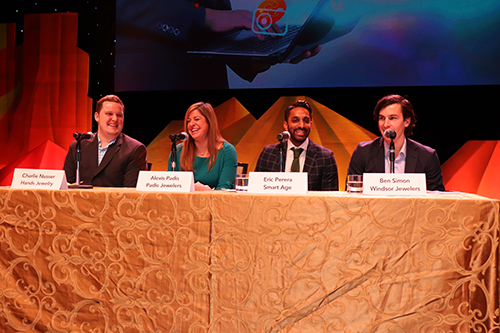Articles and News
Inside The Mind Of A Millennial Jeweler, Part One: Myths, Realities, And Marketing | February 19, 2019 (0 comments)

Scottsdale, AZ—With the jewelry industry wringing its collective hands over how to attract more Millennials, who better to ask than a group of Millennial-age jewelry store managers themselves? (Image at left: Komando.com)
At the Centurion Scottsdale show, the Monday morning keynote education session featured four successful young jewelers each poised to carry on his or her family’s business through the next generation. Panelists were Charlie Nusser of Hand’s Jewelers in Iowa City, IA; Alexis Padis of Padis Jewelers with four locations in northern California; Ben Simon of Windsor Jewelers with two stores in North Carolina; and Eric Perera of the digital agency Smart Age Solutions. Howard Hauben, Centurion president, moderated.
Charlie Nusser started the session off with a semi-joke. “As the fifth generation, my role is not to screw up!”

From left: Charlie Nusser, Alexis Padis, Eric Perera, and Ben Simon.
Hauben asked the panel to identify the biggest myths about Millennials and jewelry.
“The biggest myth is that we all live in our parents’ basement, we want to travel and not work, and we don’t like jewelry,” said Nusser. In reality, Millennials are not that drastically different from their parents, he said.
“I actually do live in my father’s basement,” laughed Ben Simon. “I think it’s that Millennials only shop online and click to buy and don’t want to work with someone standing in front of them. I think Millennials do value relationships, but differently than in the past.”
“It’s the same but different,” agreed Alexis Padis. "The consumer shopping experience has changed dramatically, and not just for Millennials. We’re a product of our environment but we still want the in-store experience for bigger purchases.”
“It’s that we all have a sense of entitlement. That’s not the case. People are looking for great design and quality craftsmanship, and they value being able to tell stories to their friends,” said Eric Perera.
“So what is different about Millennials?” asked Hauben. Nusser immediately identified the hybridization of retail, an ecosystem of online research and in-person to buy all working together.
“Having a fascinating experience is very important to Millennials,” said Simon. “When walk in here, will I be out of my element or will there be someone who understands me? Folks our age aren’t shopping as often in brick mortar but when they are, they’re doing it in a targeted way. The rare occasions they do get to have an in-store experience, that is very valuable.”
Padis said her company experiences more disconnects with Millennials on repairs than sales. “A teeny tiny diamond comes out of the setting and the world comes to an end.” Responsible sourcing is also a major difference between Millennial consumers and earlier generations, she continued. “Because we live in an increasingly transparent world, knowing where everything comes from—stones, metal—that’s more important to us than other generations. Because of technology, that’s becoming easier and easier. We’re seeing companies in the industry taking that to heart, such as Tiffany providing information on their stones.”
“We are extreme information seekers,” agreed Nusser.
He and Simon also addressed the importance of having Millennials on staff. “Being Millennial and selling to Millennials, we can relate more. We might not necessarily agree, but we can understand where they’re coming from. Sometimes people coming into a 166-year-old store might think there will be a 166-year-old waiting on them, but when they see me it puts them at ease.”
Simon agreed, but cautioned that the culture must mesh. “We can’t just hire a bunch of Millennials and expect a more conservative business model to run smoothly. But you have to try to have some—and to expect your older employees to train and read and understand them.”
“I just go by the golden rule of treating others as I want to be treated,” said Padis.
Is text message marketing a yes or no? The panel’s unanimous consensus? Yes! When you’re dealing with Millennials, it absolutely is the way to go.
“They say a text message is read within three seconds, but many of us don’t answer the phone if the number is unknown. Text is a channel we want to communicate on, and are very comfortable with. If you’re not doing it, chances someone else down the road is,” Perera emphasized.
Texting is necessary, but so is managing it, said Padis. “It’s a challenge because I don’t want staff on their phones all the time, and second, if they ever leave they take that client contact with them.” The easiest way to avoid both pitfalls is by providing staff with store-owned phones for work use, and requiring all texts to clients be done on that phone, she said.
The catch with texting is that people expect an immediate answer, even at 3 a.m. Response time is important, said Perera. “If you’re using something [on your website] that allows people to send text, they’re going to expect a response really quick. If they leave a message they might not assume you get that message. Some people don’t even know voicemail exists!”
Related: Google Exec To Jewelers: Your Ad Spending Is All Wrong!
But Nusser pointed out that even though Millennials are on their phones all the time and it is a good way to reach them, you do have to set boundaries so that you’re not woken up to talk to clients at 3 a.m.
“Google allows people to connect with a business via text. Our live chat gets hit up pretty regularly in the middle of the night,” said Padis. The more you can connect with your customer base, the more business you’ll see, she said. The best way to manage the inconvenient middle-of-the-night texts are with an auto-response that replies immediately and follow it up as soon as possible the next morning.
What should go into a text? Ben Simon urged caution. "Texting puts you in their inner circle if they feel they’re texting with the owner, but be careful what you put out there because once it’s out it’s out. So if you send a price, it can be much later they come in [after the price has changed]."
“We don’t want to put pricing out in a way we’re going to regret, but what about adding an image or video or anything that makes a text more valuable to the recipient?” asked Hauben.
“You have to be careful with engagement ring customers,” said Charlie Nusser. “You don’t want to be shopped on a brand. A lot of them come in and take a picture on their hand but I can jump in and pop the ring into a light box and send a beautiful picture. It’s a great way to get them information and give them something to show [their friends] and it’s great branding for you.” You also have to be a careful not to spoil a surprise proposal.
“Any of us can pull out a phone and get stock photos, but this is an added touch that you took time out of your day to send something you’re holding in your hand. It’s like face-to-face but with little digital in-between,” explained Simon.







